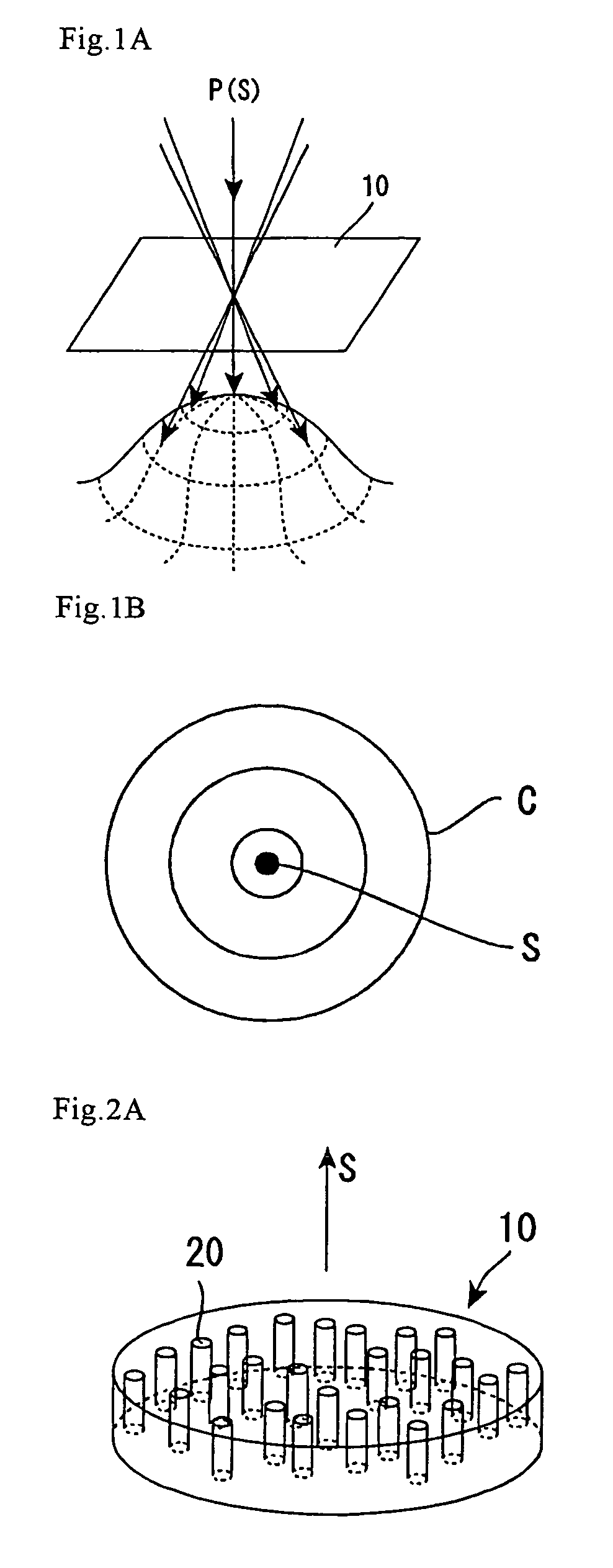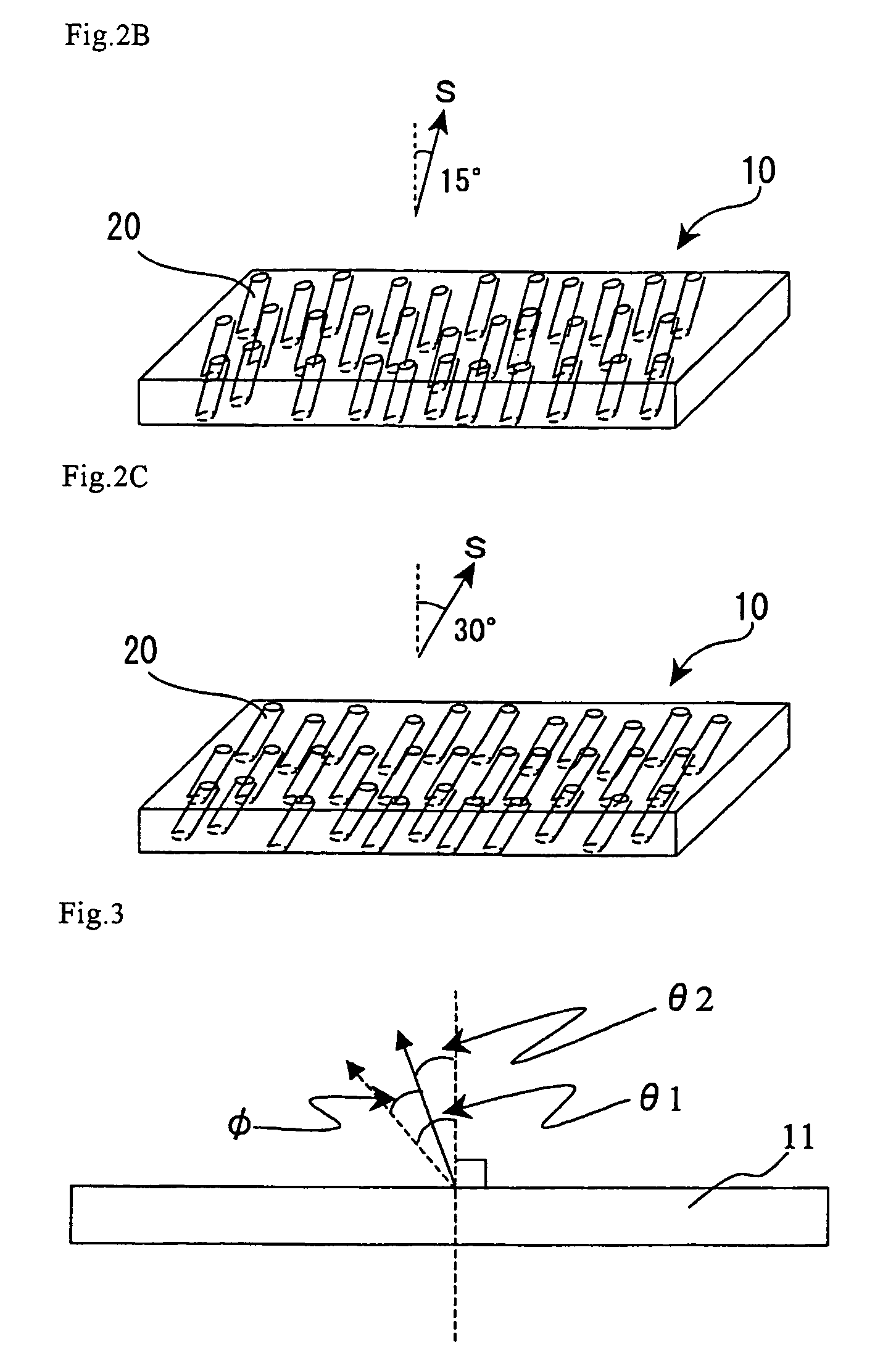Anisotropic scattering film for improving the viewing angle dependency of a liquid crystal display
a liquid crystal display and anisotropic scattering technology, applied in the field ofdisplay, can solve the problems of insufficient difficulty in production and high cost, and inferior display performance in the case of viewing obliquely, and achieve the effect of improving the viewing angle dependency of contrast ratio and large contrast ratio
- Summary
- Abstract
- Description
- Claims
- Application Information
AI Technical Summary
Benefits of technology
Problems solved by technology
Method used
Image
Examples
embodiment 1
(Preparation of First Anisotropic Scattering Film)
[0183]First, a liquid resin was discharged onto a marginal area of a polyethylene terephthalate (PET) film having a thickness of 75 μm and a size of 76 mm×26 mm (Product name: COSMOSHINE (R) A4300, produced by TOYOBO Co., Ltd.) using a dispenser and then it was cured to form an isolating wall with a height of 0.2 mm. Next, a photopolymerizable composition of the following composition was added dropwise in a region surrounded the isolating wall and then it was covered with another PET film.
>
[0184]
2-(perfluorooctyl)ethylacrylate50 parts by weight1,9-nonanediol diacrylate50 parts by weight2-hydroxy-2-methyl-1-phenylpropane-1-one 4 parts by weight
[0185]Next, ultraviolet light was irradiated to the liquid film having thickness of 0.2 mm and being sandwiched on both sides between PET films, for 1 minute at the irradiation intensity of 30 mW / cm2 vertically from an epi-illumination unit of a UV spot light source (Product name: L2859-01, manu...
embodiment 2
[0196]FIG. 7 is a perspective schematic diagram showing a constitution of a VA mode liquid crystal display 100a concerning Embodiment 2 of the present invention. Further, a relative positional relationship between the respective films and between the directions of axes of the respective films is as is shown in FIG. 7.
[0197]First, a second polarizing plate 13b, in which a supporting film on the VA mode liquid crystal cell 11a side was a second retardation film 12b, was bonded to a viewing screen side of the VA mode liquid crystal cell 11a prototyped in Embodiment 1 and a third polarizing plate 13c, in which a supporting film on the VA mode liquid crystal cell 11a side was a third retardation film 12c, was bonded to a backlight side of the VA mode liquid crystal cell 11a to prepare a VA mode liquid crystal display element 15a. Next, the first anisotropic scattering film 10a similar to that in Embodiment 1 was bonded to a viewing screen side of the VA mode liquid crystal display elemen...
embodiment 3
[0199]FIG. 8 is a perspective schematic diagram showing a constitution of a VA mode liquid crystal display 100 concerning Embodiment 3 of the present invention. Further, a relative positional relationship between the respective films and between the directions of axes of the respective films is as is shown in FIG. 8.
[0200]First, a fourth retardation film 12d was bonded to a backlight side of the VA mode liquid crystal cell 11a prototyped in Embodiment 1, and further a first polarizing plate 13a, in which a protective film on the VA mode liquid crystal cell 11a side was TAC (triacetylcellulose) film, was bonded to a backlight side of the fourth retardation film 12d and a viewing screen side of the VA mode liquid crystal cell 11a, respectively, to prepare a VA mode liquid crystal display element 15a. Next, the first anisotropic scattering film 10a similar to Embodiment 1 was bonded to a viewing screen side of the VA mode liquid crystal display element 15a to prepare a VA mode liquid c...
PUM
| Property | Measurement | Unit |
|---|---|---|
| incidence angle | aaaaa | aaaaa |
| azimuth angles | aaaaa | aaaaa |
| azimuth angles | aaaaa | aaaaa |
Abstract
Description
Claims
Application Information
 Login to View More
Login to View More - R&D
- Intellectual Property
- Life Sciences
- Materials
- Tech Scout
- Unparalleled Data Quality
- Higher Quality Content
- 60% Fewer Hallucinations
Browse by: Latest US Patents, China's latest patents, Technical Efficacy Thesaurus, Application Domain, Technology Topic, Popular Technical Reports.
© 2025 PatSnap. All rights reserved.Legal|Privacy policy|Modern Slavery Act Transparency Statement|Sitemap|About US| Contact US: help@patsnap.com



